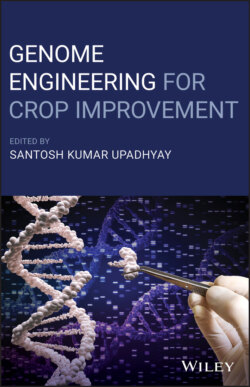Читать книгу Genome Engineering for Crop Improvement - Группа авторов - Страница 43
3.1 Introduction
ОглавлениеThe adequate supply of food providing calories and nutrients is essential for human survival. The inadequate supply of food leads toward food insecurity, threatening people around the globe. Moreover, with the rapid upsurge of population, the global population is expected to reach 8.3 billion by 2030 (United Nations, Department of Economic and Social Affairs, Population Division 2017). In response, the demand for food, fuel and shelter will also increase which will further intensify the pressure on available resource to grow more (Sundström et al. 2014). The growing population has a multi‐dimensional impact from the emergence of new threats, i.e. abiotic stress due to climate change, reduction in arable land, salinization and biotic stress. To ensure a constant food supply, there is a need to exploit available resource wisely in spite of natural threats, including climate change (Godfray et al. 2010; Jones et al. 2014). Plant breeders have utilized both natural and induced mutation techniques along with heterosis breeding to ensure food security. However, more efforts are needed to meet with current and future challenges. The current breeding approaches are focusing to maintain or increase the production per unit area, and to reduce risk of crop failure. To increase production, the breeder mostly focused on agronomic attributes, i.e. grain yield per unit area, plant population per unit area and the grain size, etc. To minimize production there is a need to understand yield stability, the plants tolerant to several biotic and abiotic stresses are prerequisite. The biotic and abiotic stresses are now considered a major threat to global food security and thus it is much more important to understand the genomics of the plant to withstand against these challenges (Butt et al. 2018). There are great efforts required to understand the loci related to disease resistance and introgression of those loci to elite germplasm. Further, diseases also cause negative impact on grain quality of major cereals whereas, balancing the plant energy required to resist against diseases without penalties of yield and quality is challenging.
To enhance the nutritional value of crops, current breeding efforts emphasized the provision of divergent and balanced diet with optimum level of vitamins and minerals to boost human health. The quality requirements vary around the globe as consumer preferences are variable depending on region and cultural values. The nutritional aspect is of unique importance as the nutrients are required in less quantity and almost two billion people across globe suffer from malnutrition, especially Zinc (Zn), Iron (Fe), Iodine (I) and vitamin A (Bhullar and Gruissem 2013). Analysis of grain quality attributes required much time and effort along with a great number of samples, mostly taken at the early stage of breeding and standard protocols must be followed (Cruz and Khush 2000).The latest accomplishments in the field of crop biotechnology enable to breakdown of information to understand the key enzymes playing their vital role in metabolic pathways, increasing the contents of required vitamins and reducing compounds, i.e. phytic acids and acrylamide‐forming amino acids. There are some cereals, i.e. Wheat, Maize and Rice which are biofortified to enhance food quality through fixing nutrition deficiencies. (Gil‐Humanes et al. 2014; Ye et al. 2000). A documented example is of Golden Rice, which is genetically engineered to markedly increase the β‐carotene to solve the problem of vitamin A deficiency (Ye et al. 2000). In this chapter, we have highlighted the application of targeted genome engineering approaches to understand and enhance the food quality with special emphasis on major crops. Based on previous findings, we have proposed the genome engineering techniques are an ultimate choice to enhance the food quality and ensure food security to the global human population.
